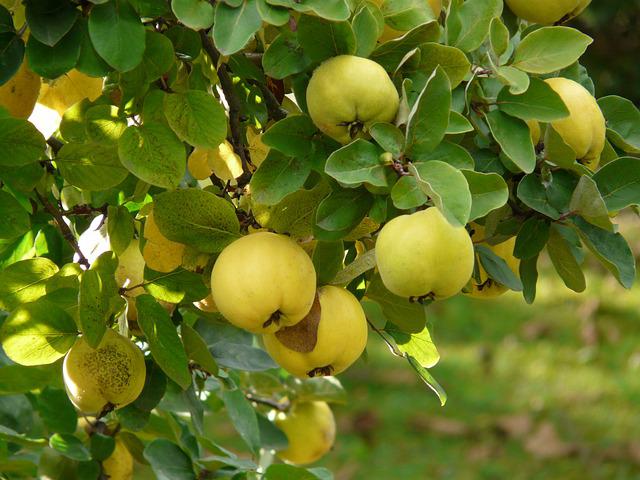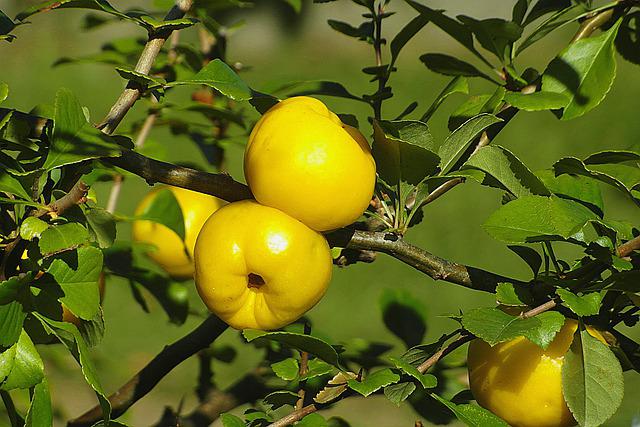What Are Quince Fruit?

Quince (Cydonia oblonga) is the only member of the genus Cydonia and belongs to the rose family (Rosaceae). They are greenish-yellow and shaped like pears, but the bumps are bigger and more uneven. Some have a pale fuzzy coat. Their leaves look shiny and waxy, and the undersides are soft like velvet.
Flowering Quince (Chaenomeles japonica) is a small shrub with fruit that looks like a quince. It is in the rose family but a different genus and species, so it is not in this guide. Think of them as long-lost relatives.
Table of Contents
History of Quince Fruit
The quince is a sweet fruit that has been around for centuries. The earliest evidence of it dated back to the 5th century BC and was known in Persia as the ‘king of fruits. Quinces were highly prized by the ancient Greeks and Romans, who used them in various dishes, including jellies, jams, wines, puddings, compotes, syrups, tarts, etc. They also used quinces as an ingredient in their liqueurs, such as amaretto and vermouth.
The popularity of quinces continued into medieval times when they were used to make sherbet or ice cream. Later on, during the Renaissance period (1400-1600), chefs used them more frequently in savory dishes such as stuffed roast pork with prunes or duck confit with dried apricots.
Today’s consumers can find quinces in a wide range of grocery stores worldwide. They are usually sold fresh but can also be found canned or frozen.

What Do Quinces Taste Like?
Quinces are a type of apple that is tart and tangy with a slightly sweet flavor. They taste like a cross between an apple and a pear and have a sweet flavor reminiscent of apricots or peaches. The fruit can be eaten fresh and used in cooked dishes or juiced. Quinces are not typically eaten in North America, so if you’re curious about the taste, it’s best to try them out when you visit Europe or Asia, where they are commonly consumed. Their pastes can be used in baking applications or to make liqueurs such as quince brandy.
How To Eat a Quince?
Quince comes in a wide variety of varieties. When ripe, they can be eaten raw, like an apple or a pear. However, most of them are too tough and astringent to eat raw, so they are usually cooked.
Simmering them in water until they’re fork-tender is another way to cook them. Then a variety of flavors are added or served on top of it.
Roasting them in the oven and using them in jams, jellies, and other desserts is also common. It resembles a hard, tart apple when eaten raw. Cooking is the preferred method of consumption for most people unless you have access to a raw form of food that can be consumed.
Health Benefits of Quince Fruit
Quince fruits are high in vitamin C, dietary fiber, and antioxidants. They may also provide benefits for the heart, skin, and brain. Here are some of the health benefits that are associated with quince fruit consumption:
Heart Health
Quinces contain flavonoids such as kaempferol which has antioxidant properties and can help lower blood pressure. In addition, they are a good source of soluble fiber, which helps reduce bad cholesterol levels and supports regularity. They may also improve stress hormone responses due to their anti-inflammatory effects.
Skin Benefit
Quinces are rich in ellagic acid, which is important in maintaining healthy skin tone by reducing inflammation and promoting wound healing.
Cancer Prevention
Quince contains high levels of polyphenols, which are antioxidant nutrients that have been linked with cancer prevention and other health benefits. In addition to polyphenols, quinces also contain anthocyanins and flavonoids.
Immunity Booster
Quince contains a lot of antioxidants, but other vitamins like vitamin C and E also help to boost the immune system in different ways. Vitamin C, for example, boosts the immune system’s production of white blood cells, the body’s first line of defense against pathogens, viruses, and bacteria.
